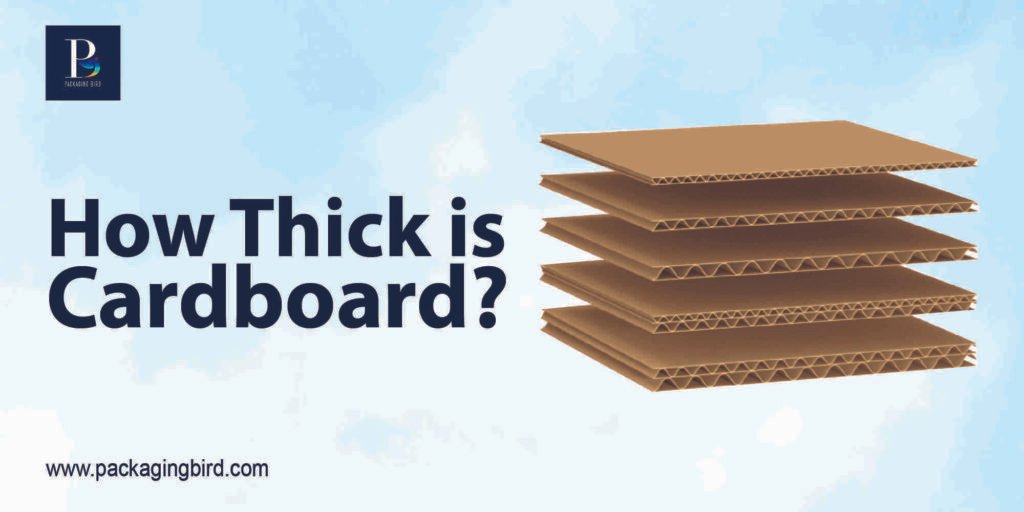When it comes to packaging, one simple question often sparks confusion: how thick is cardboard? At first glance, it may seem like just a technical detail, but in reality, the thickness of your packaging impacts everything — from product protection and shipping costs to how your brand is perceived.
Imagine receiving a delicate item in a flimsy box. No matter how great the product inside, poor packaging creates doubt about the brand. This is where understanding cardboard thickness, the types of cardboard, and even the difference between corrugated vs cardboard becomes crucial.
Let’s break down everything you need to know about cardboard, from its thickness to its weight, and help you make the best decision for your packaging needs.
Why Does Cardboard Thickness Matter?
The thickness of cardboard determines:
- Protection: Thicker materials guard against crushing, tearing, and external pressure.
- Weight & Shipping Costs: Balancing strength with lightness keeps logistics affordable.
- Brand Experience: Strong, well-designed types of cardboard boxes instantly convey quality and reliability.
Without the right cardboard thickness, even the best product risks arriving damaged, is a costly mistake for any business.
The Different Types of Cardboard
Cardboard isn’t one-size-fits-all. Here are the main types of cardboard used in packaging:
- Paperboard (Chipboard) – Thin, smooth, and lightweight, ideal for retail packaging like cereal boxes.
- Corrugated Cardboard – Built with a fluted layer between liners, offering strength and cushioning.
- Solid Board – Dense and durable, perfect for premium or luxury types of cardboard boxes.
Each option has unique properties and different cardboard thickness levels to suit your packaging goals.
How Thick is Cardboard in Inches?
Cardboard thickness is usually measured in inches or millimeters, and it varies by type:
- Paperboard: Around 0.010–0.030 inches.
- Single-wall corrugated cardboard: Roughly 1/8 inch.
- Double-wall corrugated cardboard: About 1/4 inch.
- Triple-wall corrugated cardboard: Close to 1/2 inch, designed for heavy-duty shipping.
So, if you’re asking how thick is cardboard in inches, the answer depends on the material you choose.
How Thick is Corrugated Cardboard?
Corrugated cardboard is the workhorse of packaging. Its thickness depends on the number of walls and the flute size:
- Single-wall: Commonly used for shipping lightweight products.
- Double-wall: Provides extra cushioning for fragile items.
- Triple-wall: Almost as strong as wood, ideal for industrial shipments.
In short, when considering how thick is corrugated cardboard, the options range from 1/8 inch to 1/2 inch, giving you flexibility based on product needs.
Corrugated vs Cardboard: What’s the Difference?
Many people use the terms interchangeably, but there’s a big difference between corrugated vs cardboard:
- Cardboard: often refers to thin paperboard used for retail packaging.
- Corrugated cardboard: has fluted layers, making it stronger and more resistant to impact.
If you’re shipping products, corrugated is almost always the safer choice.
How Much Does Cardboard Weigh?
Understanding how much does cardboard weigh is essential for shipping and storage planning. On average:
- Single-wall corrugated: About 0.69 lbs per square foot.
- Double-wall corrugated: Up to 1.03 lbs per square foot.
This balance of strength and lightness makes corrugated cardboard the preferred option for e-commerce and industrial use.
Choosing the Right Types of Cardboard Boxes
The perfect box depends on your product’s weight, fragility, and shipping conditions.
- For fragile items → Double-wall corrugated.
- For lightweight products → Paperboard or single-wall.
- For luxury goods → Solid board with premium finishes.
Investing in the right types of cardboard boxes ensures both safety and brand impact.
Final Thoughts
So, how thick is cardboard? The answer isn’t just about measurements — it’s about balancing protection, cost, and presentation. Whether you’re comparing corrugated vs cardboard, exploring types of cardboard boxes, or asking how much does cardboard weigh, the right choice ensures your product arrives safely and your brand makes a lasting impression.
At Packaging Bird, we specialize in custom, durable, and eco-friendly packaging solutions. From selecting the right cardboard thickness to designing standout boxes, we help you create packaging that protects your product and builds your brand.. Contact us today and let’s make your brand unforgettable.
FAQS
- What does cardboard thickness mean?
It refers to the measurement of cardboard layers that determine strength and durability. - How thick is cardboard in inches for shipping?
Most shipping boxes use 1/8 to 1/2 inch thickness, depending on product needs. - How thick is corrugated cardboard compared to standard cardboard?
Corrugated is much thicker, ranging from single-wall at 1/8 inch to triple-wall at 1/2 inch. - How much does cardboard weigh per square foot?
Anywhere from 0.69 lbs to 1.03 lbs, depending on the wall strength. - What types of cardboard are most common for packaging?
Paperboard for retail, corrugated for shipping, and solid board for premium packaging.











